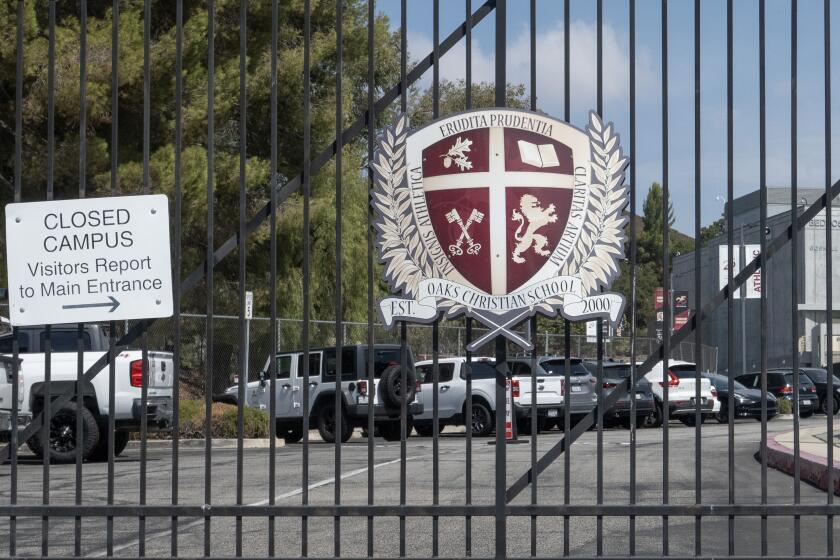Cal State Not Backing Off From Taylor Ranch Site
California State University trustees Wednesday reaffirmed their commitment to building a Ventura County campus on scenic Taylor Ranch and took steps that could lead to condemnation of a portion of the sprawling property.
However, Cal State officials, who were stunned last month by the refusal of the ranch’s owners to negotiate, declined to indicate whether they intend to condemn the site.
“The Taylor property remains far superior to any other potential sites which have come to our attention,” said Tom Bernard, vice chairman of the trustee committee charged with site acquisition. “We hope the owners will consider this and share in our interest to develop a legacy for the future.”
Appraisal Ordered
The trustees also directed their staff to prepare an environmental impact report for the property and a thorough appraisal so a firm offer can be made.
“Those steps would be required if they were intending to condemn the property,” said Robert H. Francis, a specialist in eminent domain procedures in the state attorney general’s office. “It certainly doesn’t require them to condemn, but these are steps consistent with condemnation.”
Under the California Code of Civil Procedure, public agencies can acquire properties through eminent domain if a proposed project is in the public interest and the project serves the greatest public good while causing the least private injury.
Owners of the ranch last month withdrew the property from consideration, citing the incompatibility of a university campus with continued oil production on the land.
The attorney representing Santa Barbara heiress Cynthia Wood, who owns the site with her mother, Ailene B. Claeyssens, said Wednesday that the Cal State decision had not changed their stance.
‘Made Their Position Clear’
“I don’t know what more we can add to this dialogue,” J. Robert Andrews of Santa Barbara said. “Obviously our clients will consider the situation on a daily basis, but I think they’ve made their position clear, and there has been no change in that.”
The procedures outlined by the board Wednesday will take about six months. The trustees have until July, 1990, to acquire a site or risk losing the $7 million allocated for the project by the Legislature.
In deciding at a meeting here to stick with Taylor Ranch, the university trustees bypassed four other contenders that had sought to capitalize on the ranch owners’ rejection of the campus possibility.
The most prominent of those was an Oxnard site owned by Ag Land Services Inc., which had offered a free 80-acre parcel and $5 million in cash.
“I’m surprised,” said Dave O. White, vice president of the Somis-based company. “I personally don’t think this is in the best interests of the taxpayers of the state.”
Also thrown into the fray were two more Ventura sites, one owned by the Lloyd family, which owns more than 3,600 acres of hillside land in western Ventura, and the other by the Walker-Hearne families, who own 2,000 acres in eastern Ventura.
Additionally, the Lusk Co., which had spent a year in unsuccessful negotiations to sell Cal State 110 acres near the Ventura Harbor, indicated that their land is still available.
However, Cal State trustees, who voted in March to purchase up to 550 acres of Taylor Ranch, said the hillside bluff was still their favorite.
“The trustees believe that the Taylor Ranch property is very well suited to long-term development because of location, community support and accessibility,” Bernard said.
Cal State’s troubled search for a Ventura County campus began more than two years ago, when a state-commissioned study predicted increased population and higher college enrollments in the region.
For 14 years, Cal State Northridge and UC Santa Barbara have offered classes jointly to as many as 1,000 local students in a cramped office building in mid-town Ventura.
Cal State officials proposed building a facility to serve about 2,500 third- and fourth-year students although they have said that such a campus could be expanded into a four-year university serving 5,000 students within the next 20 years.
In September, 1986, the university’s board of trustees decided the best place for that development was the farmland owned by the Lusk Co.
Search Reopened
But negotiations to purchase the property became mired in disagreement over the funding of infrastructure costs such as road widening and sewer lines. A year later Cal State reopened its search for a site.
At a December, 1987, meeting, the university’s site selection committee narrowed the choices to three, and in March, Cal State officials decided that Taylor Ranch was the most advantageous and picturesque.
However, questions about oil rights and the owners’ intentions quickly brought negotiations to a halt. On June 3, Wood and Claeyssens wrote Cal State with a message to “direct your efforts elsewhere for the location of a new campus.”
Wherever the campus ultimately is constructed, Cal State officials have estimated that it will take about four years of planning and development before students ever enter a classroom.
More to Read
Sign up for Essential California
The most important California stories and recommendations in your inbox every morning.
You may occasionally receive promotional content from the Los Angeles Times.










